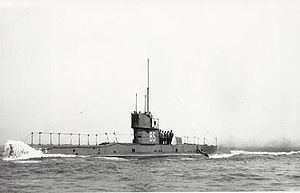Name HMS E5 Laid down 9 June 1911 Construction started 9 June 1911 | Cost £106,700 Commissioned 28 June 1913 Length 54 m Builder Barrow-in-Furness | |
 | ||
Fate Sunk presumedly by naval mine , 7 March 1916 | ||
HMS E5 was a British E-class submarine built by Vickers Barrow-in-Furness. She was laid down on 9 June 1911 and was commissioned on 28 June 1913. She cost £106,700. E5 was sunk, probably by striking a mine, on 7 March 1916.
Contents
Design
The early British E-class submarines, from E1 to E8, had a displacement of 652 tonnes (719 short tons) at the surface and 795 tonnes (876 short tons) while submerged. They had a length overall of 180 feet (55 m) and a beam of 22 feet 8.5 inches (6.922 m), and were powered by two 800 horsepower (600 kW) Vickers eight-cylinder two-stroke diesel engines and two 420 horsepower (310 kW) electric motors. The class had a maximum surface speed of 16 knots (30 km/h; 18 mph) and a submerged speed of 10 knots (19 km/h; 12 mph), with a fuel capacity of 50 tonnes (55 short tons) of diesel affording a range of 3,225 miles (5,190 km; 2,802 nmi) when travelling at 10 knots (19 km/h; 12 mph), while submerged they had a range of 85 miles (137 km; 74 nmi) at 5 knots (9.3 km/h; 5.8 mph).
The early 'Group 1' E class boats were armed with four 18 inches (460 mm) torpedo tubes, one in the bow, one either side amidships, and one in the stern; a total of eight torpedoes were carried. Group 1 boats were not fitted with a deck gun during construction, but those involved in the Dardanelles campaign had guns mounted forward of the conning tower while at Malta Dockyard.
E-Class submarines had wireless systems with 1 kilowatt (1.3 hp) power ratings; in some submarines, these were later upgraded to 3 kilowatts (4.0 hp) systems by removing a midship torpedo tube. Their maximum design depth was 100 feet (30 m) although in service some reached depths of below 200 feet (61 m).
Service history
E5 had a very short career before and after her commissioning. She had an engine room explosion on 8 June 1913, 20 days before commissioning, that resulted in 13 deaths. A further three men were killed when there was an oil blow back into the starboard engine off St Ann's Head. The submarine depot ship HMS Adamant and Alligator carried the medical team out to meet E5 on her way into Pembroke Dock. CERA James Alexander Greenall, son of Henry & Alice Greenall of Preston, Lancs., was killed at the scene. Engineer Commander Walter Lancelot Moore lost both legs and an arm and suffered third degree burns, dying in hospital at Pembroke Dock and returned for burial in Hampshire, believed Winchester. Leading Stoker Lewis Alfred Clarke of Esher in Surrey died in Pembroke Dock Naval Hospital. Greenall and Clarke are buried at Pembroke Dock Military Cemetery in plots R244 (Greenall) and R246 (Clarke). Ten other men were seriously injured, although all civilian staff from Barrow were safe and unharmed.
Loss
E5 was lost on 7 March 1916 while rescuing the survivors of the trawler Resono, just north of Juist in the North Sea.
There were different theories about the reason for the loss of E5. One theory was that she struck a mine, possibly after straying into a German minefield upon being sighted by the German light cruiser Regensburg. Another theory attributed her loss to depth charge attack by torpedo boats escorting the battlecruiser Seydlitz.
In 2016 divers found the wreck of E5 off the island of Schiermonnikoog. Her hatches were open, which suggests that the crew had tried to escape. There was no sign of damage to her hull, indicating that she had not sunk as a result of enemy action.
